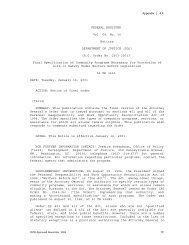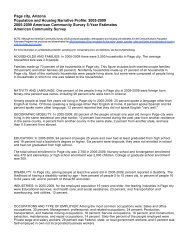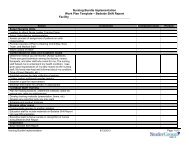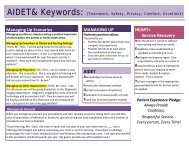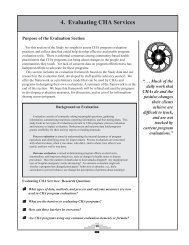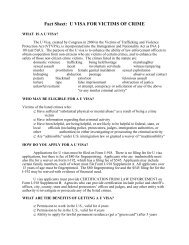Arizona Rural Health Clinic Designation Manual - Arizona Center for ...
Arizona Rural Health Clinic Designation Manual - Arizona Center for ...
Arizona Rural Health Clinic Designation Manual - Arizona Center for ...
Create successful ePaper yourself
Turn your PDF publications into a flip-book with our unique Google optimized e-Paper software.
B. Interpretive Guidelines <strong>for</strong> <strong>Rural</strong> <strong>Health</strong> <strong>Clinic</strong>s (con’t)<br />
2. <strong>Clinic</strong>s Operating on July 1, 1977. Potential applicants under this grandfather provision still have to<br />
meet the rural location requirement. The other requirement under this provision is that the Secretary has<br />
determined that the area served has an insuffi cient supply of primary care physicians. Facilities providing<br />
services on July 1, 1977, in a nonurbanized area which is determined to have unmet needs <strong>for</strong> primary<br />
health care but which is not a designated shortage area are potential applicants. There<strong>for</strong>e, the facility may<br />
be primarily serving a designated area but not located in a designated shortage area. It must be determined<br />
whether the location of the clinic is an appropriate part of a service area which includes areas or populations<br />
which have been designated either as having a health manpower shortage, or as being medically<br />
underserved. Aiding this determination will be previous PHS decisions made on behalf of the Secretary.<br />
The answer to question V on CMS-29 is an important indicator. Several PHS programs provide or have<br />
provided grant support to enable the facility to provide health care to designated areas. These programs do<br />
not require that the facility be located in a designated shortage area. Many of these facilities were operating<br />
with PHS grant support prior to enactment of the <strong>Rural</strong> <strong>Health</strong> <strong>Clinic</strong> Services Act of 1977 (P.L.95-210) and<br />
may constitute certifi able RHC applicants.<br />
Some examples of these PHS programs are National <strong>Health</strong> Service Corps (KHSC), Migrant <strong>Health</strong>, <strong>Health</strong><br />
Underserved <strong>Rural</strong> Areas (HURA), and <strong>Rural</strong> <strong>Health</strong> Initiative (RHI). Prior to P.L.95-210 a number of states<br />
had programs to assist their rural areas with greater access to primary care. The location of the facilities<br />
developed by these programs was determined by valid criteria established by the State, although location<br />
in a designated shortage area may not have been one of them. These facilities are also potential applicants<br />
under this grandfather provision.<br />
When it is determined that an applicant clinic not located in a designated shortage area may be a potential<br />
applicant under this grandfather provision, develop the following in<strong>for</strong>mation and submit it to the CMS RO<br />
<strong>for</strong> a determination as to whether the facility meets the requirements of this ‘grandfather provision:<br />
-- A description of the geographic boundaries of the facility’s service area;<br />
-- In<strong>for</strong>mation developed through consultation with the PHS RO, staff about whether the area,<br />
or any portion of the area, had ever been reviewed <strong>for</strong> designation under any of the applicable<br />
sections of the PHS Act;<br />
-- Identification of any designated population group or institution in the facility’s service area;<br />
-- In<strong>for</strong>mation secured from the appropriate <strong>Health</strong> Systems Agency and the State <strong>Health</strong><br />
Planning and Development Agency and about the primary care resources available<br />
in the facility’s service area;<br />
-- In<strong>for</strong>mation about any planning, developmental, or operating funds awarded to the facility by<br />
the county, State, or Federal Government to assist in providing, greater access- to health care<br />
in the area;<br />
-- In<strong>for</strong>mation about the factors considered in determining where the facility was to be located;<br />
and<br />
-- Any additional in<strong>for</strong>mation the SA or RO feels is relevant.<br />
III. PHYSICAL PLANT AND ENVIRONMENT (42 CFR 491.6)<br />
A. Physical Plant Safety. To insure the safety of patients, personnel, and the public, the physical plant<br />
should be maintained consistent with appropriate State and local building, fi re, and safety codes. Reports<br />
prepared by State and local personnel responsible <strong>for</strong> insuring that the appropriate codes are met should<br />
be available <strong>for</strong> review. Determine whether the clinic has safe access and is free from hazards that may<br />
affect the safety of patients, personnel, and the public.<br />
B. Preventive Maintenance. A program of preventive maintenance should be followed by the clinic. This<br />
includes inspection of all clinic equipment at least yearly, or as the type, use, and condition of equipment<br />
dictates; the safe storage of drugs and biologicals (see 42 CFR 491.6(b)(2)) and inspection of the facility to<br />
assure that services are rendered in a clean and orderly environment. Inspection schedules and reports<br />
19



